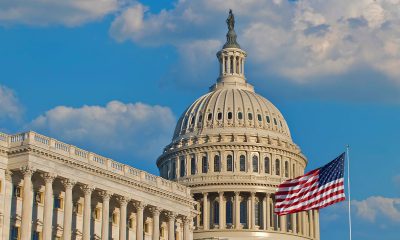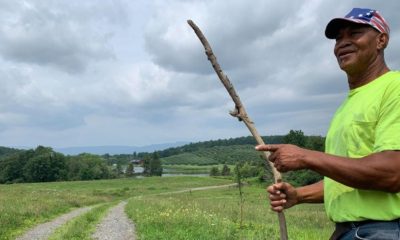Bay Area
Proposed Legislation Wants to Turn Parking Lots into Solar Energy Farms
The office of State Sen. Josh Becker (D-San Mateo), estimates that creating solar canopies above 400 square miles of parking lots in the state could provide 26 gigawatts of power, which is enough energy to power 6.5 million homes. For context, the state estimates it needs 110 gigawatts of solar power in order to turn 100 percent carbon-neutral by 2045.

By Olivia Wynkoop | Bay City News Foundation
Newly proposed state legislation seeks to motivate companies to turn their parking lots into functional-use solar farms.
Senate Bill 49, announced during the first day of California’s new legislative session, would create a tax incentive for commercial building owners to build “solar canopies” — overhanging solar panel structures — above their large parking lots.
State Sen. Josh Becker, D-San Mateo, author of the legislation, hopes SB 49 will create more local clean energy in cities and suburbs by taking advantage of spaces capable of having solar panels above them, rather than seeking out rare and expensive plots of undeveloped land.
“That’s what makes the solar canopy concept so appealing, because it wouldn’t require any more land, it would just give parking lot owners an incentive to make dual use of their lots by essentially putting a miniature power plant above all those cars,” Becker said in a press release.
The bill would also prevent the need for large-consuming regions to outsource their clean power sources to rural areas, which not only requires installing expensive, lengthy transmission lines, but partly inhibits agricultural areas from using their land for food and livestock production.
In a nation hoping to wean itself off of its dependency on fossil fuels, cheap and quick clean energy is critical, which is why most solar farms across the nation are built on open, undeveloped spaces like deserts, croplands and grasslands and forests, according to a global inventory published in the science journal Nature.
Compared to building thousands of small solar farms in urban spaces, large rural energy farms are technically cheaper, easier to manage and ultimately more efficient to harvest a big quantity of energy from.
But following this summer’s strained energy grid scare, legislators are getting creative to find new ways to provide clean energy to Californians in any way possible.
In one experiment, the state is funding a $20 million project to test the effectiveness of solar canopies above unprotected irrigation canal systems, called “Project Nexus”. The hope is to simultaneously reduce water evaporation and generate clean energy.
Becker’s office estimates that creating solar canopies above 400 square miles of parking lots in the state could provide 26 gigawatts of power, which is enough energy to power 6.5 million homes. For context, the state estimates it needs 110 gigawatts of solar power in order to turn 100 percent carbon-neutral by 2045.
“This is one of the many tools we’re going to need to use to hit our targets of using 90% clean energy by 2035 and achieving 100% carbon neutrality by 2045,” Becker said. “In my view, this is relatively low-hanging fruit. We’ve got the land available — now the challenge is to make better use of it.”
Just last month, the French Senate passed a policy that requires all parking lots with more than 80 spaces to install solar canopies. The French government said this legislation has the potential to generate 10 nuclear reactors worth of energy.
And in March, Washington state allowed businesses to pay off their sales and use taxes from buying solar canopy equipment over an eight-year period.
An assigned Senate policy committee will review SB 49 in early 2023.
Alameda County
Seth Curry Makes Impressive Debut with the Golden State Warriors
Seth looked comfortable in his new uniform, seamlessly fitting into the Warriors’ offensive and defensive system. He finished the night with an impressive 14 points, becoming one of the team’s top scorers for the game. Seth’s points came in a variety of ways – floaters, spot-up three-pointers, mid-range jumpers, and a handful of aggressive drives that kept the Oklahoma City Thunder defense on its heels.

By Y’Anad Burrell
Tuesday night was anything but ordinary for fans in San Francisco as Seth Curry made his highly anticipated debut as a new member of the Golden State Warriors. Seth didn’t disappoint, delivering a performance that not only showcased his scoring ability but also demonstrated his added value to the team.
At 35, the 12-year NBA veteran on Monday signed a contract to play with the Warriors for the rest of the season.
Seth looked comfortable in his new uniform, seamlessly fitting into the Warriors’ offensive and defensive system. He finished the night with an impressive 14 points, becoming one of the team’s top scorers for the game. Seth’s points came in a variety of ways – floaters, spot-up three-pointers, mid-range jumpers, and a handful of aggressive drives that kept the Oklahoma City Thunder defense on its heels.
One of the most memorable moments of the evening came before Seth even scored his first points. As he checked into the game, the Chase Center erupted into applause, with fans rising to their feet to give the newest Warrior a standing ovation.
The crowd’s reaction was a testament not only to Seth’s reputation as a sharpshooter but also to the excitement he brings to the Warriors. It was clear that fans quickly embraced Seth as one of their own, eager to see what he could bring to the team’s championship aspirations.
Warriors’ superstar Steph Curry – Seth’s brother – did not play due to an injury. One could only imagine what it would be like if the Curry brothers were on the court together. Magic in the making.
Seth’s debut proved to be a turning point for the Warriors. Not only did he contribute on the scoreboard, but he also brought a sense of confidence and composure to the floor.
While their loss last night, OKC 124 – GSW 112, Seth’s impact was a game-changer and there’s more yet to come. Beyond statistics, it was clear that Seth’s presence elevated the team’s performance, giving the Warriors a new force as they look to make a deep playoff run.
Activism
Oakland Post: Week of November 26 – December 2, 2025
The printed Weekly Edition of the Oakland Post: Week of November 26 – December 2, 2025

To enlarge your view of this issue, use the slider, magnifying glass icon or full page icon in the lower right corner of the browser window.
Activism
Oakland Post: Week of November 19 – 25, 2025
The printed Weekly Edition of the Oakland Post: Week of November 19 – 25, 2025

To enlarge your view of this issue, use the slider, magnifying glass icon or full page icon in the lower right corner of the browser window.
-

 Activism3 weeks ago
Activism3 weeks agoOakland Post: Week of November 12 – 18, 2025
-

 Activism4 weeks ago
Activism4 weeks agoOakland Post: Week of November 5 – 11, 2025
-

 Activism2 weeks ago
Activism2 weeks agoIN MEMORIAM: William ‘Bill’ Patterson, 94
-

 Activism3 weeks ago
Activism3 weeks agoHow Charles R. Drew University Navigated More Than $20 Million in Fed Cuts – Still Prioritizing Students and Community Health
-

 #NNPA BlackPress3 weeks ago
#NNPA BlackPress3 weeks agoThe Perfumed Hand of Hypocrisy: Trump Hosted Former Terror Suspect While America Condemns a Muslim Mayor
-

 Bay Area3 weeks ago
Bay Area3 weeks agoNo Justice in the Justice System
-

 #NNPA BlackPress3 weeks ago
#NNPA BlackPress3 weeks agoProtecting Pedophiles: The GOP’s Warped Crusade Against Its Own Lies
-

 #NNPA BlackPress2 weeks ago
#NNPA BlackPress2 weeks agoTrump’s Death Threat Rhetoric Sends Nation into Crisis






















































